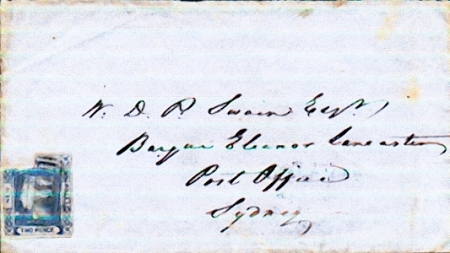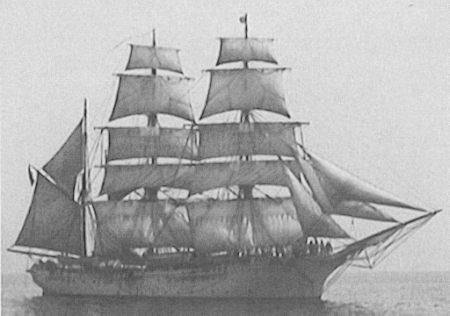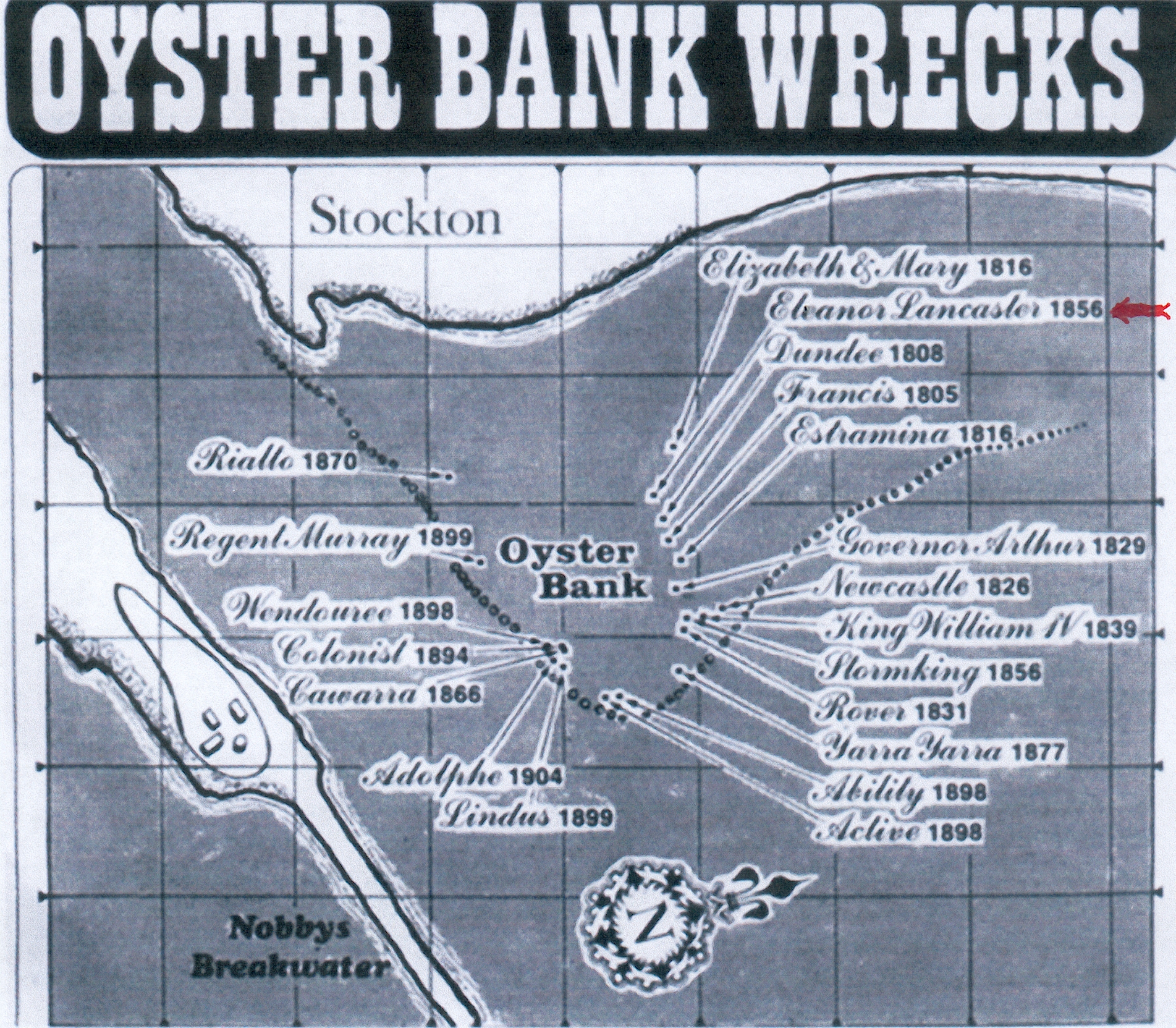When I first considered this paper I could not find any information on the addressee of this letter, so I decided to discuss this ship which had a short but interesting sailing history, with journeys to and from Australia, and finally its demise on the coast of New South Wales. Its association with Australia is shown on this cover which is addressed to W.D.P. Swain Esq, Barque Eleanor Lancaster, Port Office, Sydney. It has a 2d blue imperforate stamp, the first N.S.W. stamp with a portrait of the young Queen Victoria, issued initially in 1851. The reverse was not shown on eBay, but the vendor states that the cover was dated 1852 (Figure 1).

I thought that it was reasonable to suspect that Mr. Swain was expected to disembark or embark on the ship, in Sydney. Having written the first paragraph, I decided to research ‘W.D.P. Swain’ one more time, and to my surprise, two hits were immediately found. The first was three lines, but most importantly it tied Swain to the Eleanor Lancaster, as follows: “Swain, W.D.P., Surgeon W.D.P. Swain was a surgeon on the emigrant ship “King William” from Plymouth to Adelaide 1851, the “Eleanor Lancaster” from Sydney to Amoy and back 1851-52 and the “Lalla Rookh” to San Francisco 1852.”
The second reference was more expansive with two paragraphs which I will summarise: One surgeon who superintended a privately chartered ship, the King William, bound for Adelaide in March-July 1851 was Dr. W.D.P. Swain who kept a daily journal. Although the ship did not carry government-assisted emigrants it received the usual visits from the port’s chaplain and the local emigration authorities before it sailed. A father brought his child to Swain suffering from diarrhoea and demanded homeopathic medicine, which was in the surgeon’s medical chest. The remedy suited the child so well that Swain continued to prescribe it successfully for other children.
Like numerous surgeons, Dr. Swain was faced with a ‘mad man’ who crept around the ship frightening the emigrants. He found that a dose of morphine calmed the deluded patient, and the voyage continued uneventfully except for extended bouts of sea sickness. Swain was expected to supervise the housekeeping routines, and enforce (hygiene) regulations. After official inspection in Adelaide, he was told that his was the only emigrant ship for some time that had arrived without one or more deaths on board.
The Barque ‘Eleanor Lancaster’ was built in 1839 in Maryport, Cumbria, on the north-west of England, the site of an early Roman fort, on the River Ellen, probably at Ritson’s ship building firm. It was launched in 1840 and the first master was Captain P. Cowley (1840-44) and Captain Francis. Lodge was the second master (1845-53). Its tonnage (new units) was 480 tons, and amongst its voyages were the following: sailed for Liverpool (1840-43); Bombay (1844); Port Phillip (1845); Lima (1846); and, Sydney (1847-53). The Sydney Morning Herald, September 1st, 1847 wrote that the Eleanor Lancaster made an excellent passage of 101 days. “She experienced very adverse winds off this coast and was compelled to come round Van Diemen’s Land. The Eleanor Lancaster is the Post Office packet for June, and has brought a large mail, consisting of twenty-two bags (4,480 letters and 17,800 newspapers)”.
The barque also was one of seven vessels that sailed from Sydney or Hobart to San Francisco at the time of the gold rush in California. It left Sydney on January 21, 1849 and arrived in San Francisco on April 2, after a voyage of 71 days. A cabin passage was £30 and a steerage passage £10.
Upon arrival in San Francisco, her crew deserted and the captain used her along the Sacramento River as a “grog shop” and “hospital”. She was moved to San Francisco and rented as a bonded storeship until March 1, 1850 for $700 per month.
The next and last entry for the barque is problematic, either the year date for the wreck is wrong, there was a second Eleanor Lancaster of 480 tons, or the original listing for the ship of 1840-54 was incorrect, for on a voyage from Newcastle N.S.W. to Melbourne on November 7, 1856 it was wrecked at Stockton, near Newcastle, blown by a gale onto oyster banks.
Additional research showed that ship wreck did occur on November 7, 1856, and that more than 200 wrecks have occurred in the Newcastle region, “many on the infamous Oyster Bank”. Additional information was found on the barque: in 1855 it was registered in Melbourne, and its length was 109 feet; the crew clung to the rigging throughout the night and were finally rescued due mainly to a seaman, William Skilton, who made 3 trips in a small boat to the wreck, despite raging seas.
A barque is a vessel with at least three masts, all of them fully square rigged except for the sternmost one, which is fore- and aft-rigged. A picture of the ill-fated Eleanor Lancaster is not available but it was a wooden three-masted barque which was the most common deep-water cargo-carrier of the 19th century (Figure 2).

Addendum (February 2009): An email correspondent from Spokane, Washington State, USA has asked me a question about a medal that has been in her family for years, the engraving on which, reads: ‘In commemoration of his exertions to serve the crew of the Barque Eleanor Lancaster during the storm of the 7th Novr, Newcastle N.S.W. 1856′ (Figure 3).

The reverse is inscribed: ‘Presented to Willm Holmes’. The diameter of the medal is ca. 3.5 cms and the thickness is ca. 2mms (Figure 4).

To date no information concerning the issuance of the medal has been found, and William Holmes (known to the family as Uncle Willy) has not yet been identified. Can you help in regards to the issuance of the medal(s)?
Addendum (April 2010): Tom Wynn, Newcastle N.S.W. emailed with a column from The Sydney Morning Herald on 15 January 1857, which had a header ‘The Late Wrecks At Newcastle’, It described the awards (Money &/or Medals) awarded and in Class Four there were the names of 15 men of the life-boat who rescued the sailors on the Eleanor Lancaster. William Holmes whose medal was shown above is indicated by the red arrow (Figure 5).
.jpg)
An additional figure showing the ship wrecks at Oyster Bank, near Newcastle is seen with the Eleanor Lancaster arrowed (Figure 6).
